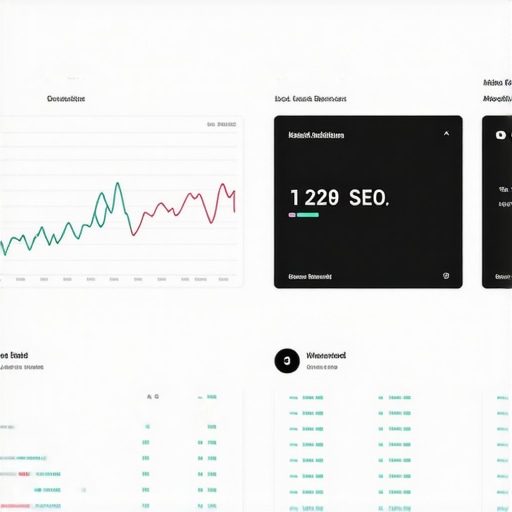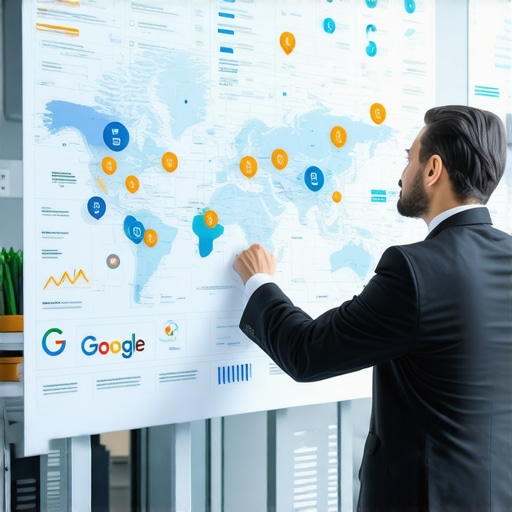Unlocking the Power of Maps SEO: Why Google Visibility Is a Strategic Imperative in 2024
As digital landscapes evolve, the importance of Maps SEO in securing top-tier Google visibility becomes undeniable for local businesses and global brands alike. The shifting algorithms and user behaviors demand a nuanced understanding of how to optimize for local search and map rankings. In this article, we delve into the sophisticated strategies that can elevate your Google Maps presence in 2024, leveraging the latest SEO insights and technical advancements.
Decoding the Semantic Web: How Contextual Relevance Enhances Map Rankings
In 2024, Google’s algorithmic focus pivots towards semantic understanding, making contextual relevance a cornerstone of effective Maps SEO. It’s no longer enough to optimize keywords; instead, embedding semantically related terms—such as local landmarks, service descriptions, and niche-specific jargon—within your Google My Business (GMB) profile and website content enhances relevance signals. This semantic enrichment aligns your business with user intent, thereby boosting your map visibility.
Leveraging Data-Driven Local Signal Optimization
Advanced map SEO tactics involve meticulous management of local signals, including NAP consistency, reviews, and behavioral metrics. For instance, maintaining uniform Name, Address, Phone Number (NAP) across all directories prevents algorithmic confusion, while actively cultivating high-quality reviews can significantly influence your rank. Integrating schema markup for local business details further empowers Google to interpret your data accurately, reinforcing your prominence in local searches.
What Are the Complexities of Voice Search Integration in Maps SEO?
With the rise of voice-activated devices, optimizing for voice search has become a complex but essential component of Maps SEO. Voice queries tend to be conversational and question-oriented, demanding that businesses adapt their content strategy accordingly. Incorporating natural language, long-tail keywords, and FAQ sections tailored for voice search can bridge the gap between traditional SEO and emerging voice-driven local searches.
How Can AI and Machine Learning Revolutionize Your Maps SEO Strategy?
Emerging AI-driven tools analyze vast datasets to identify patterns and opportunities within local search landscapes. These technologies enable predictive insights about user behavior, competitor positioning, and algorithm updates. By integrating AI analytics, businesses can refine their strategies proactively, ensuring sustained visibility and adaptation to algorithmic shifts in 2024.
Explore Further: Elevate Your Local Search Strategy with Expert Insights
To stay ahead in the competitive Maps SEO arena, continuous learning and adaptation are key. Explore detailed techniques in our comprehensive guide to Maps SEO techniques for 2024 and contribute your insights to the community of SEO professionals shaping the future of local search optimization.
Mastering Hyperlocal Signals: The Next Frontier in Maps SEO
As local search algorithms become more sophisticated, understanding and optimizing hyperlocal signals is crucial. These signals include real-time data such as foot traffic patterns, localized social media activity, and even environmental factors like weather or events. Integrating these signals into your SEO strategy can give your business a competitive edge, ensuring your listing appears at the right moment and location.
Can Behavioral Data Unlock Hidden Opportunities in Map Rankings?
Behavioral metrics—such as click-through rates, dwell time, and call-to-action responses—are increasingly influencing Google Maps rankings. By analyzing these data points, businesses can identify which aspects of their listings resonate most with local audiences. For example, optimizing for high-engagement keywords or improving your call-to-action prompts can boost your visibility. Leveraging analytics tools, like those discussed in our comprehensive guide to local signal management, enables data-driven decision-making that elevates your local SEO game.
How Can Businesses Leverage AI to Predict Future Map Search Trends?
Artificial intelligence and machine learning are revolutionizing local SEO by providing predictive insights into search trends. These technologies analyze vast datasets — including user behavior, competitor movements, and seasonal fluctuations — to forecast future opportunities. Businesses that adopt AI-powered tools can proactively adjust their strategies, such as updating their NAP information or refining their service descriptions, to align with emerging search patterns. This proactive approach is essential for maintaining top rankings in a dynamic local search landscape.

Visualize AI-driven maps analytics dashboard highlighting predictive trends and local signals for strategic planning.
What Role Do Niche-Specific Optimization Techniques Play in 2024?
Beyond general local SEO practices, niche-specific optimization can dramatically improve your Google Maps visibility. For instance, a legal firm might focus on optimizing for legal jargon and local case references, while a restaurant could emphasize menu keywords and local food trends. Tailoring your content and citations to your niche ensures that your business resonates with a highly targeted audience, thus improving relevance and rankings. Exploring these nuanced strategies can be challenging without expert guidance; therefore, consulting specialized resources like our niche-focused Maps SEO strategies can provide valuable insights.
Share your thoughts or experiences with hyperlocal signals and predictive analytics in the comments — your insights can help others optimize their local search strategies effectively.
Harnessing the Power of Local Schema Markup for Enhanced Map Visibility
In the intricate world of Maps SEO, leveraging schema markup—specifically local business schema—is a game-changer. This microdata helps search engines better understand your business details, from geographical coordinates to service areas, thereby improving your ranking signals. Implementing comprehensive schema markup not only boosts your Google My Business profile’s relevance but also enhances your appearance in rich snippets and local cards.
Recent studies, such as the 2024 Local SEO Benchmark Report by Moz, highlight that schema implementation correlates strongly with higher Local Pack placements. Ensuring your schema is correctly formatted and consistently updated across your website and listings is critical for maintaining a competitive edge.
What are the best practices for implementing schema markup to optimize for local search?
Best practices include using JSON-LD format for compatibility, validating your markup with tools like Google’s Rich Results Test, and aligning schema data precisely with your NAP information. Regular audits of your schema markup ensure it remains accurate amid changing business details or services.

Illustration of schema markup code snippets integrated into a business website for local SEO enhancement.
Integrating Hyperlocal Data Sources: The Next Frontier
Hyperlocal signals—such as real-time foot traffic, local event attendance, and social media check-ins—are becoming increasingly influential in Map rankings. Advanced businesses utilize IoT sensors and social listening tools to gather this granular data, integrating it into their SEO strategy to signal proximity relevance and activity peaks.
For example, a retail store could analyze foot traffic patterns during local events or weather conditions to optimize listing visibility. This dynamic approach transforms static local SEO into a proactive, real-time optimization process, giving businesses a significant advantage in competitive markets.
How can businesses effectively collect and utilize hyperlocal signals for Map SEO?
Effective collection involves deploying sensors, partnering with third-party data providers, and monitoring social media activity with advanced analytics platforms. The integration process requires sophisticated data management systems that can parse and act upon these signals, translating them into actionable SEO tactics such as timing promotions or updating business hours dynamically.
Embracing Visual Data to Elevate Map Visibility: How Infographics and Interactive Maps Drive Engagement
In the rapidly evolving landscape of Maps SEO, integrating compelling visual content such as infographics and interactive maps can significantly enhance user engagement and dwell time, which are critical ranking factors. Advanced SEO practitioners now leverage data visualization tools to create rich, shareable assets that not only inform but also entice backlinks, thereby reinforcing authority signals.
What Are the Cutting-Edge Techniques for Leveraging Structured Data Beyond Basic Schema?
Beyond standard local business schema, sophisticated applications involve implementing nested schemas, such as event schemas for local happenings or product schemas for service-based businesses. These layered microdata structures enable Google to better contextualize your offerings, resulting in enhanced rich snippets and increased click-through rates. Experts also recommend utilizing JSON-LD formats for compatibility and ease of updates.
How Can Advanced Schema Markup Strategies Be Effectively Managed at Scale?
Managing schema markup at scale requires automation tools and validation frameworks that ensure consistency across diverse listings and web properties. Regular audits with tools like Google’s Structured Data Testing Tool or Schema App can prevent semantic discrepancies that may diminish your local relevance. Incorporating schema management into your overall content workflow promotes agility and accuracy.
The Role of Local Content Personalization in Capturing Hyperlocal Market Share
Personalized local content, tailored to specific neighborhoods, demographics, or even real-time event data, can dramatically improve relevance signals. Businesses deploying geofencing technology and localized content variants create hyper-relevant user experiences, which in turn, influence proximity-based ranking algorithms. Adaptive content strategies that respond to hyperlocal signals foster loyalty and boost visibility in competitive markets.

Illustration of a dynamic local content personalization dashboard featuring geofencing data and user engagement metrics.
How Can Voice Search Optimization Evolve with Multimodal and Context-Aware Technologies?
Future-proofing Maps SEO requires integrating multimodal search capabilities, combining voice, visual, and contextual data. Context-aware AI assistants that interpret user intent based on environmental cues, device type, and previous behavior demand a holistic content approach. Developing conversational, intent-driven content that seamlessly aligns with various interaction modes enhances discoverability across multiple platforms.
Exploring the Impact of Augmented Reality (AR) on Hyperlocal Map Engagement
Augmented reality applications are transforming how users interact with local environments, offering immersive experiences that connect physical locations with digital information. Embedding AR features into your local SEO strategy—such as virtual tours or AR-driven promotions—can differentiate your business and increase foot traffic, especially in retail and hospitality sectors. Staying abreast of AR integration standards and user adoption trends ensures your business remains at the forefront of innovative local search experiences.
What Are the Best Practices for Integrating AR Features into Local SEO Campaigns?
Best practices include aligning AR content with your core offerings, optimizing load times, and ensuring mobile compatibility. Collaborating with AR development specialists and leveraging platforms like Google ARCore or Apple ARKit can streamline integration. Additionally, promoting AR experiences through social media and local listings amplifies reach and engagement.
Expert Insights & Advanced Considerations
1. Embrace Semantic Enrichment: Mastering the nuances of contextual relevance in 2024 requires integrating semantically related terms into your local listings and website content. This strategy aligns your business with user intent more precisely, boosting map rankings.
Implementing detailed schema markup and local landmarks enhances Google’s understanding of your relevance, positioning your business for higher visibility in competitive markets.
2. Leverage Hyperlocal Data for Real-Time Optimization: Utilizing IoT, social listening, and environmental signals enables hyper-targeted adjustments. For example, dynamically updating your business hours based on foot traffic patterns can significantly improve user engagement and ranking.
Integrating these granular signals into your SEO strategy transforms static listings into active, real-time assets that resonate with local audiences.
3. Prioritize Niche-Specific Optimization: Tailoring your content to industry-specific jargon and local references differentiates your listing. For instance, a legal firm optimizing for case law or a restaurant emphasizing local food trends can attract a highly targeted audience.
This niche focus enhances relevance and attracts quality engagement, reinforcing your position in local search results.
4. Harness AI and Machine Learning for Predictive Search Trends: Advanced analytics tools forecast upcoming search patterns, enabling proactive strategy adjustments. Regularly updating NAP data, refining service descriptions, and optimizing for emerging keywords ensure sustained visibility.
Adopting AI-driven insights keeps your local SEO strategy agile and forward-looking, essential for maintaining dominance in 2024’s dynamic landscape.
Curated Expert Resources
- Google’s Structured Data Guidelines: Essential for implementing accurate schema markup, ensuring your business details are correctly interpreted by search engines.
- Moz Local Search Optimization Reports: Offers in-depth analysis of local SEO factors, including schema, reviews, and NAP consistency.
- BrightLocal’s Hyperlocal Signal Insights: Provides tools for analyzing real-time, hyperlocal data like foot traffic and social media activity.
- SEO by the Sea’s Semantic Web Articles: Deep dives into semantic relevance and evolving search engine understanding.
- Google’s Local Search Algorithms Blog: Stay updated with official insights on algorithm changes impacting Maps SEO.
Final Expert Perspective
In 2024, mastering Maps SEO demands a sophisticated blend of semantic enrichment, hyperlocal data utilization, and niche-specific optimization, all empowered by AI insights. By leveraging authoritative resources and staying ahead of evolving algorithms, businesses can secure a formidable presence in local search landscapes. Engage with these advanced strategies and contribute your insights to the ongoing evolution of local SEO excellence—your expertise shapes the future of Google visibility.



